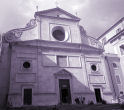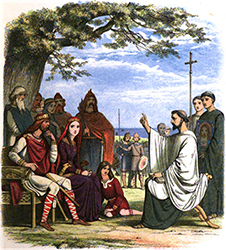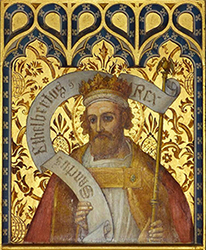Lent: February 24th
Saturday after Ash Wednesday
Other Commemorations: Ethelbert of Kent, King (RM)
» Enjoy our Liturgical Seasons series of e-books!
Then he questioned his father, "How long has this been happening to him"? He replied, "Since childhood. It has often thrown him into fire and into water to kill him. But if you can do anything, have compassion on us and help us." Jesus said to him, " 'If you can!' Everything is possible to one who has faith." Then the boy's father cried out, "I do believe, help my unbelief!" Jesus, on seeing a crowd rapidly gathering, rebuked the unclean spirit and said to it, "Mute and deaf spirit, I command you: come out of him and never enter him again" (Mark 9:21-26)

The station for today is at the church dedicated to St. Augustine of Hippo. Michalangelo was one of the artists commissioned for the decoration of the church. The Renaissance façade, one of the first in this style, is built of travertine marble said to be from the ruins of the Colosseum.
Thanks to Fear of the Lord, There Is No Fear of Evil
History, in fact, is not alone in the hands of dark powers, chance or human choices. Over the unleashing of evil energies, the vehement irruption of Satan, and the emergence of so many scourges and evils, the Lord rises, supreme arbiter of historical events. He leads history wisely towards the dawn of the new heavens and the new earth, sung in the final part of the book under the image of the new Jerusalem (cf. Revelation 21-22).
It must be reaffirmed, therefore, that God is not indifferent to human events, but penetrates them realizing his "ways," namely his plans and his efficacious "deeds."
According to our hymn, this divine intervention has a very specific purpose: to be a sign that invites all the peoples of the earth to conversion. Nations must learn to "read" in history a message of God. Humanity's history is not confused and without meaning, nor is it given over, without appeal, to the malfeasance of the arrogant and perverse. There is the possibility to recognize divine action hidden in it. In the pastoral constitution "Gaudium et Spes," Vatican Council II also invites the believer to scrutinize, in the light of the Gospel, the signs of the times to see in them the manifestation of the very action of God (cf. n. 4 and 11). This attitude of faith leads man to recognize the power of God operating in history, and thus to open himself to fear of the name of the Lord. In biblical language, in fact, this "fear" does not coincide with dread, but is the recognition of the mystery of the divine transcendence. Because of this, it is the basis of faith and is joined with love: "the Lord your God requires of you, but to fear the Lord your God, to walk in all his ways, to love him, to serve the Lord your God with all your heart and with all your soul" (cf. Deuteronomy 10:12).
Following this line, in our brief hymn, taken from Revelation, fear and glorification of God are united: "Who will not fear you, Lord, or glorify your name" (15:4)? Thanks to fear of the Lord there is no fear of the evil that rages in history and one takes up again with vigor the journey of life, as the prophet Isaiah declared: "Strengthen the hands that are feeble, make firm the knees that are weak, say to those whose hearts are frightened: Be strong, fear not!'" (Isaiah 35: 3-4).
Excerpted from Thanks to Fear of the Lord, There Is No Fear of Evil, Pope Benedict XVI, May 11, 2005
Things to Do:
- Your children may want to spend their Saturday afternoon learning about different local charitable organizations or needy families to whom the alms from the family's Lenten Jar will be given.
St. Ethelbert of Kent (or Albert)
Ethelbert (or Albert) was (560–616), King of Kent. He married Bertha, daughter of the Frankish king, Charibert, and afforded her every opportunity for the exercise of her religion. When he was baptized by Saint Augustine, 597, his supremacy in southern Britain led to the baptism of 10,000 of his countrymen within a few months. Thenceforth he was the watchful father of the Anglo-Saxon Church.
 Among others he founded at Canterbury the church which was afterwards to be the primatial cathedral of England. He issued their first written laws to the English people. He was popularly called Saint Albert, and is known under this name as titular saint of numerous churches in England. His relics were preserved at Canterbury.
Among others he founded at Canterbury the church which was afterwards to be the primatial cathedral of England. He issued their first written laws to the English people. He was popularly called Saint Albert, and is known under this name as titular saint of numerous churches in England. His relics were preserved at Canterbury.
—from New Catholic Dictionary
Highlights and Things to Do:
- Find out more about St. Ethelbert:
- St. Ethelbert or Albert was originally buried in the side chapel of Saint Martin in the abbey church of Saints Peter and Paul, with his relics later translated to Canterbury.






